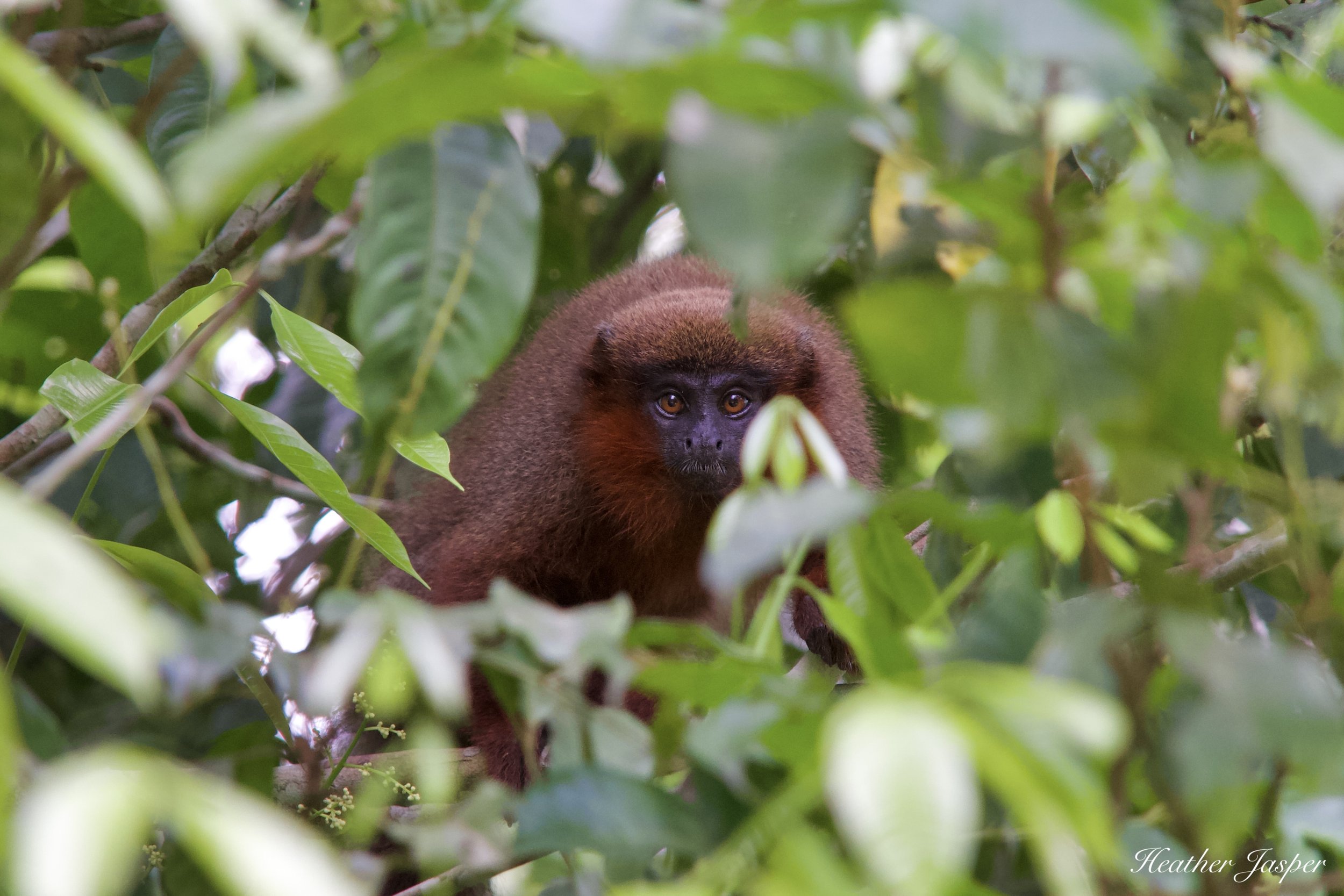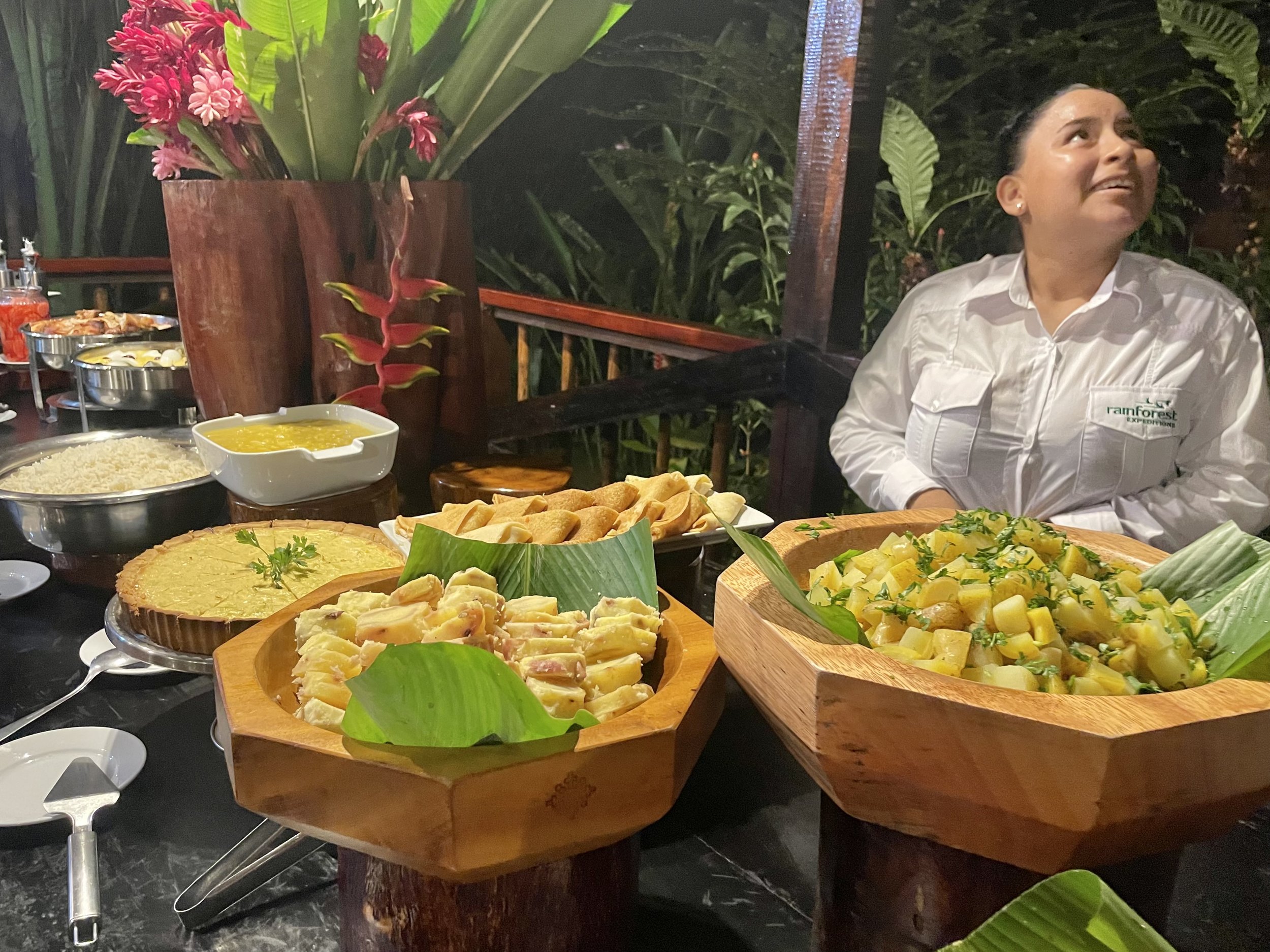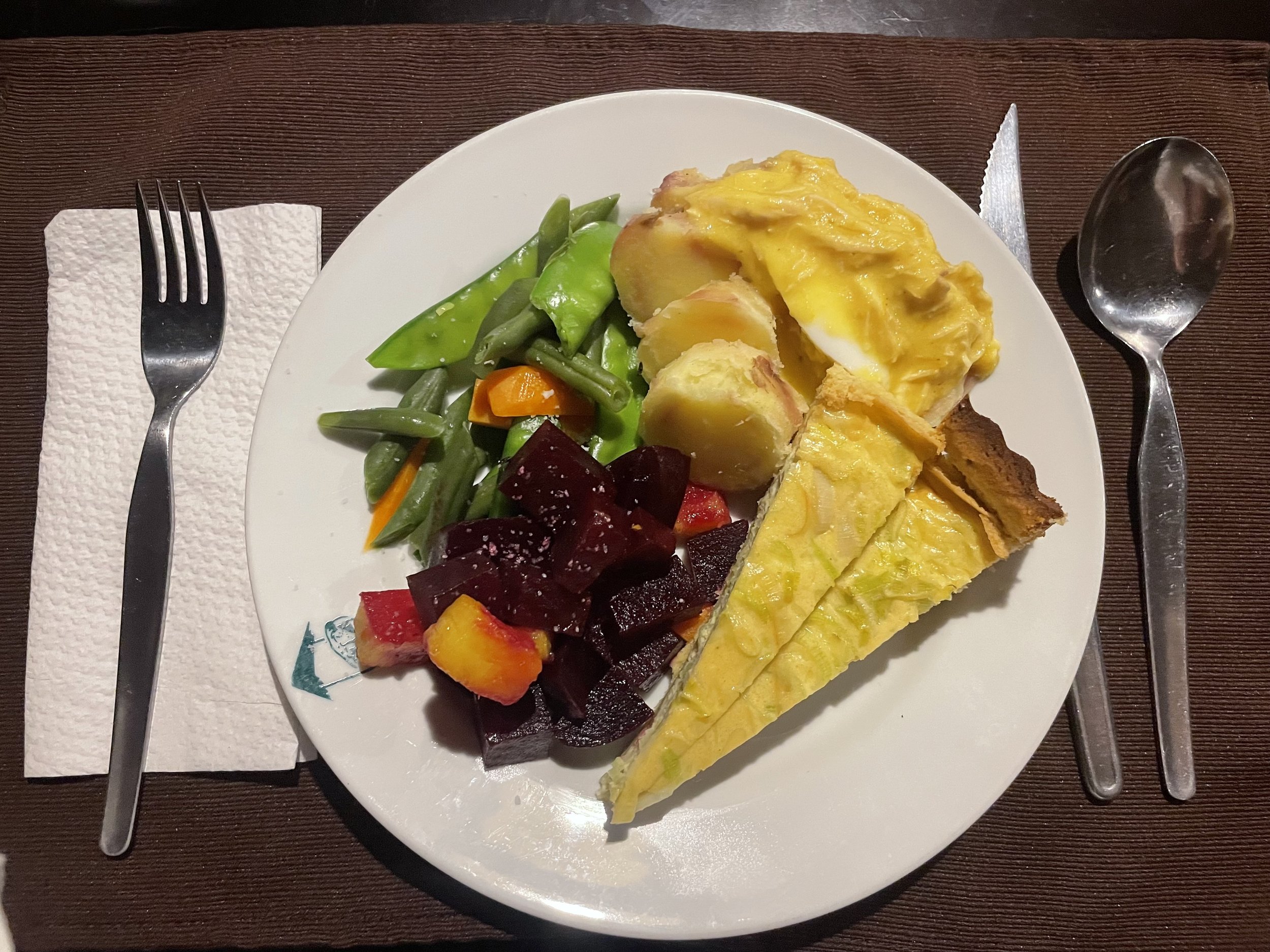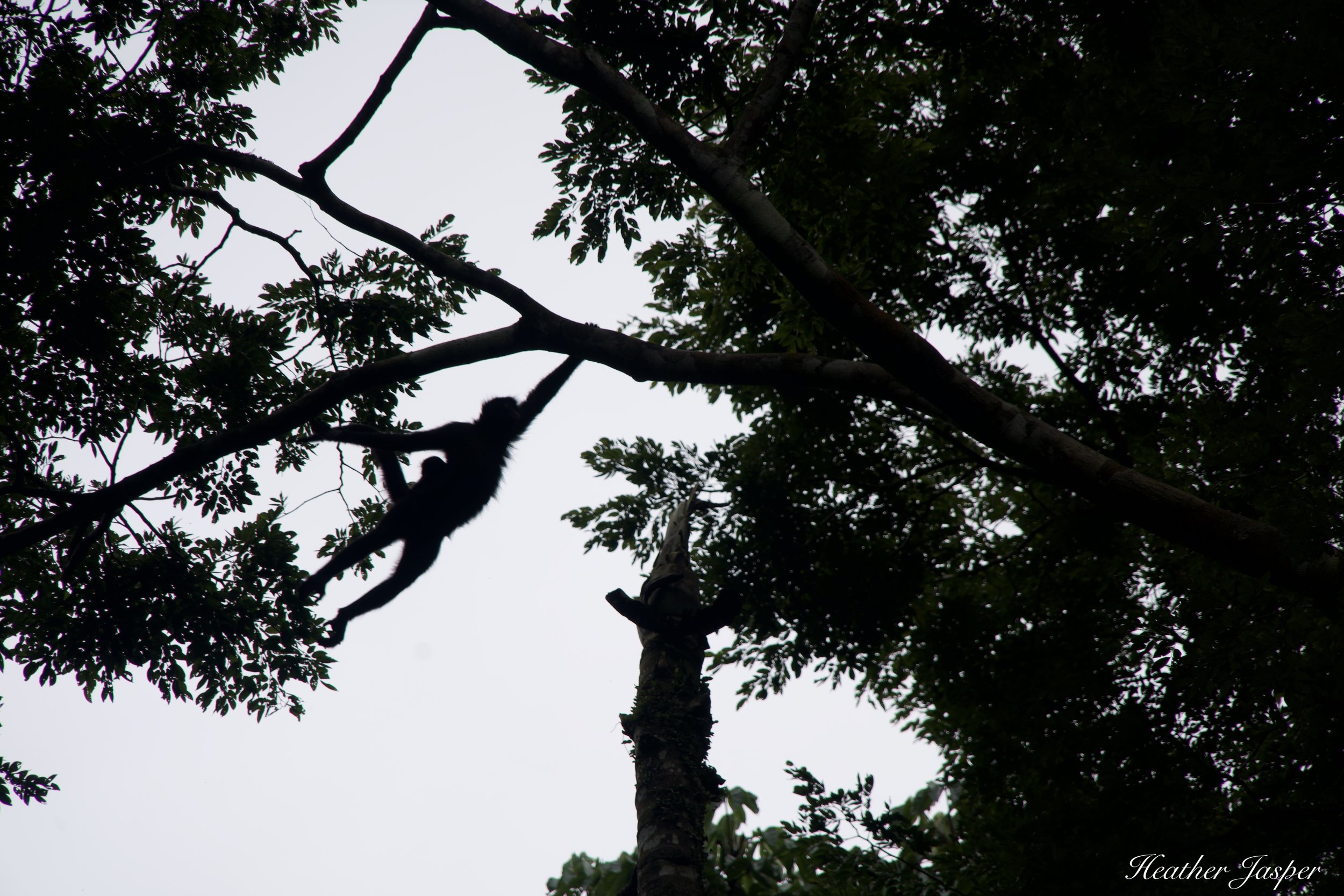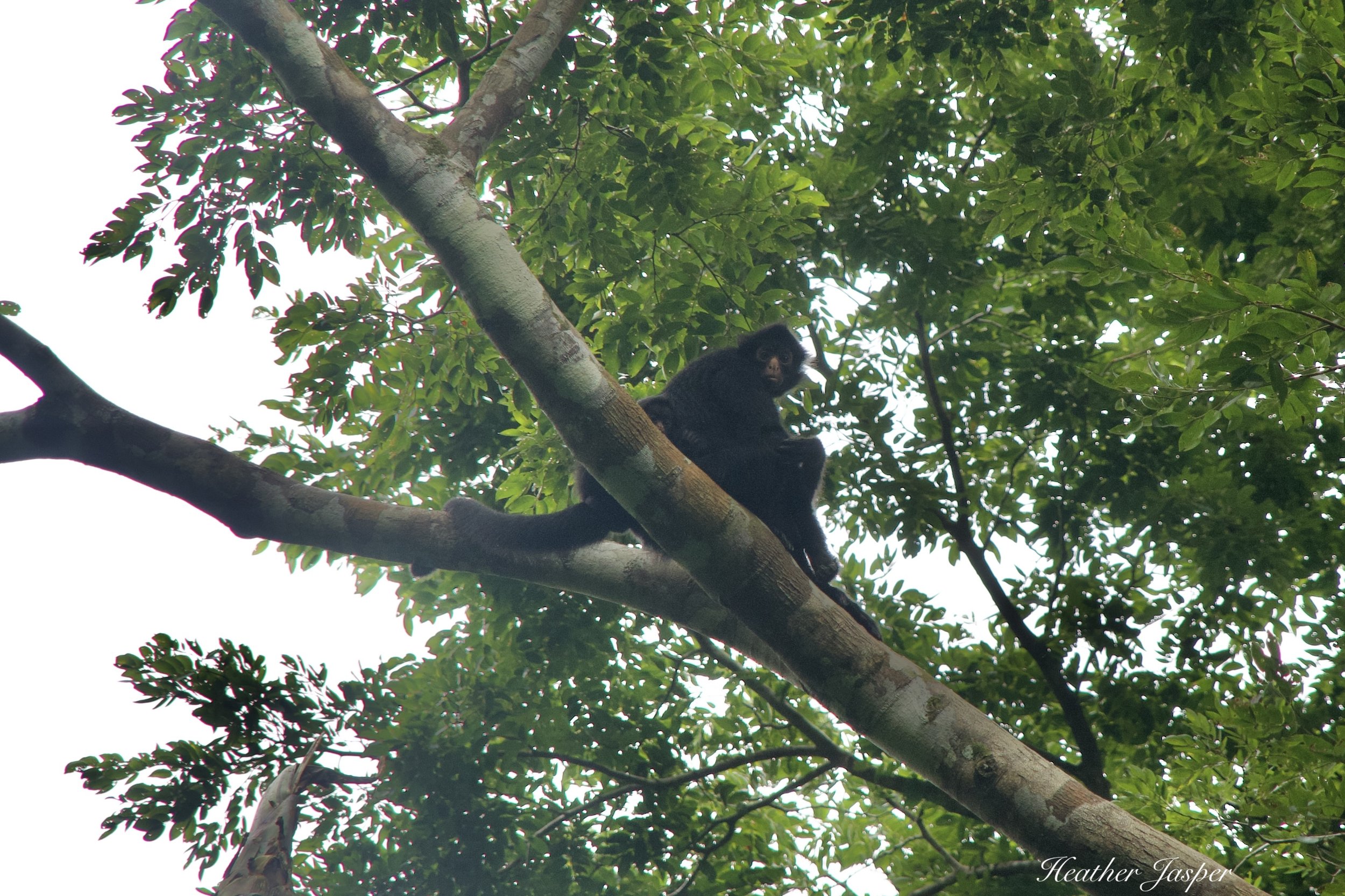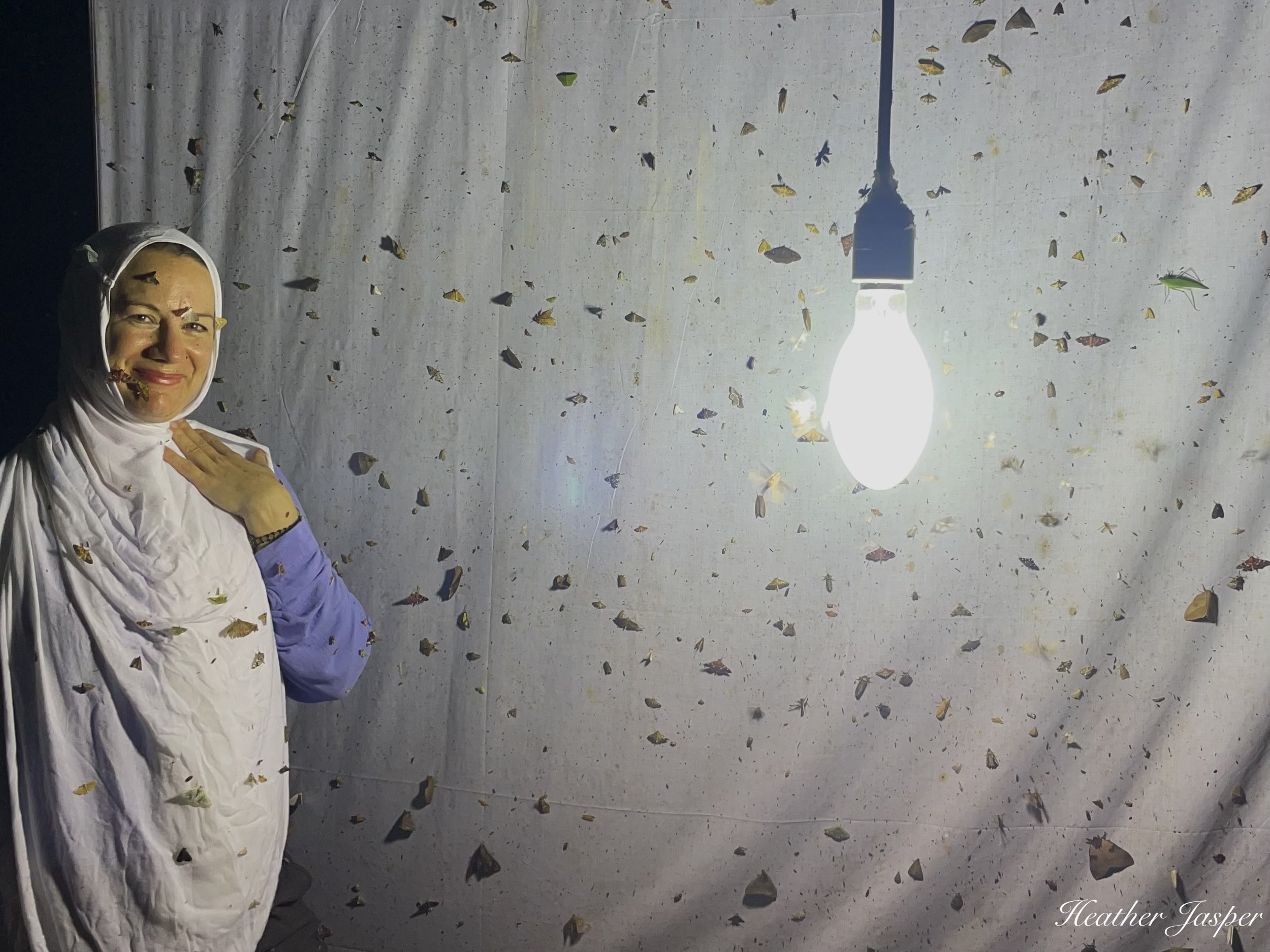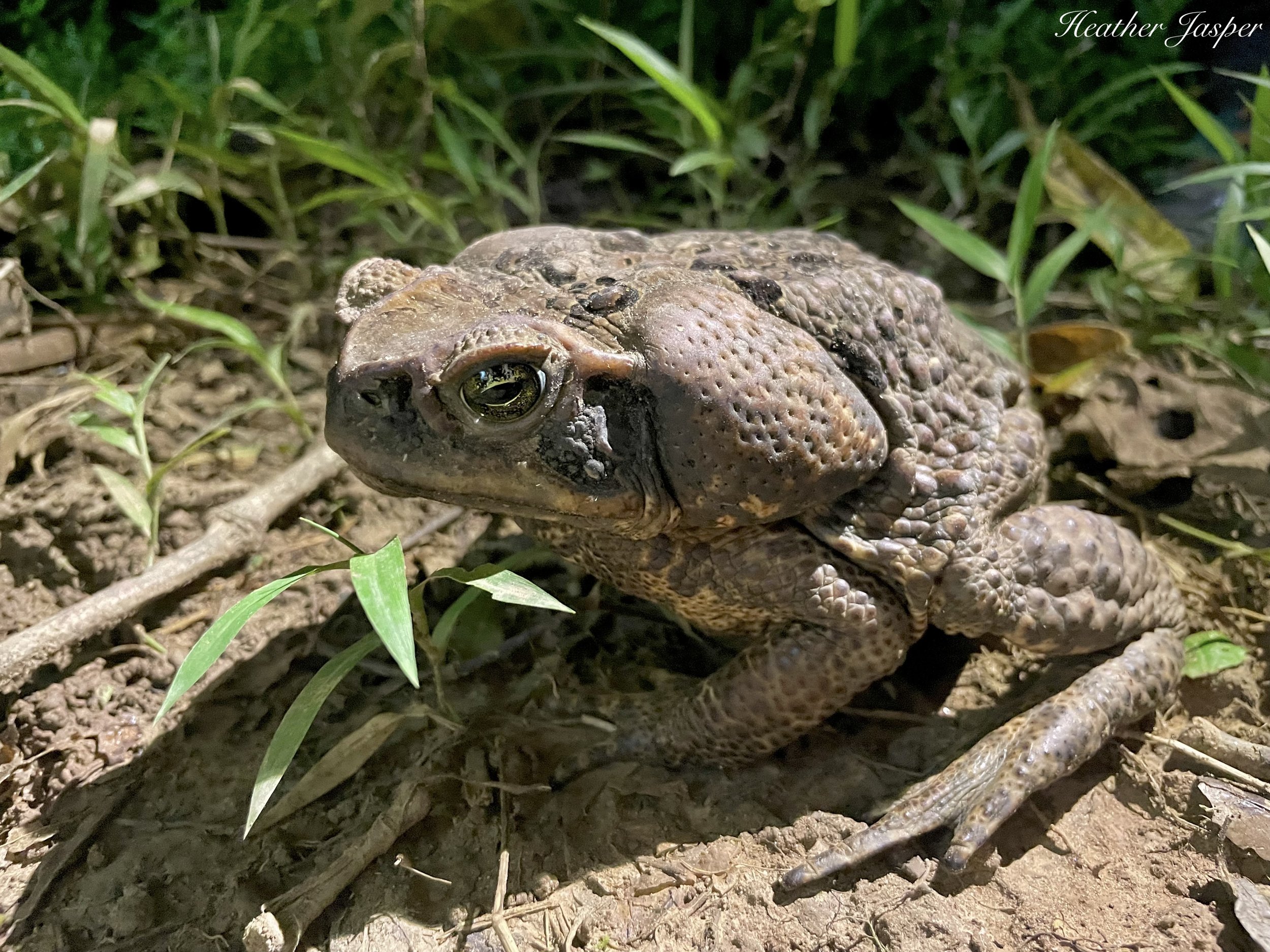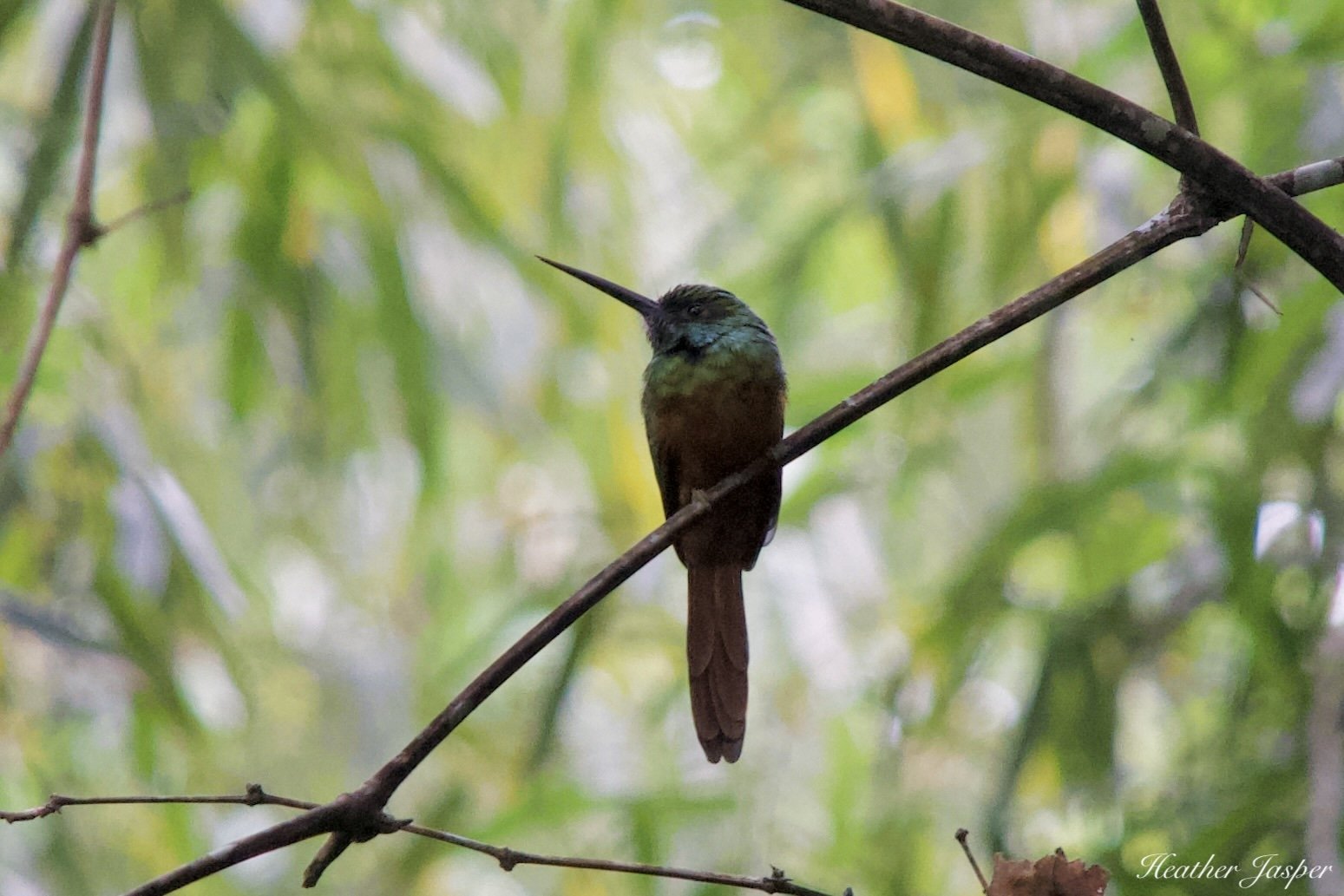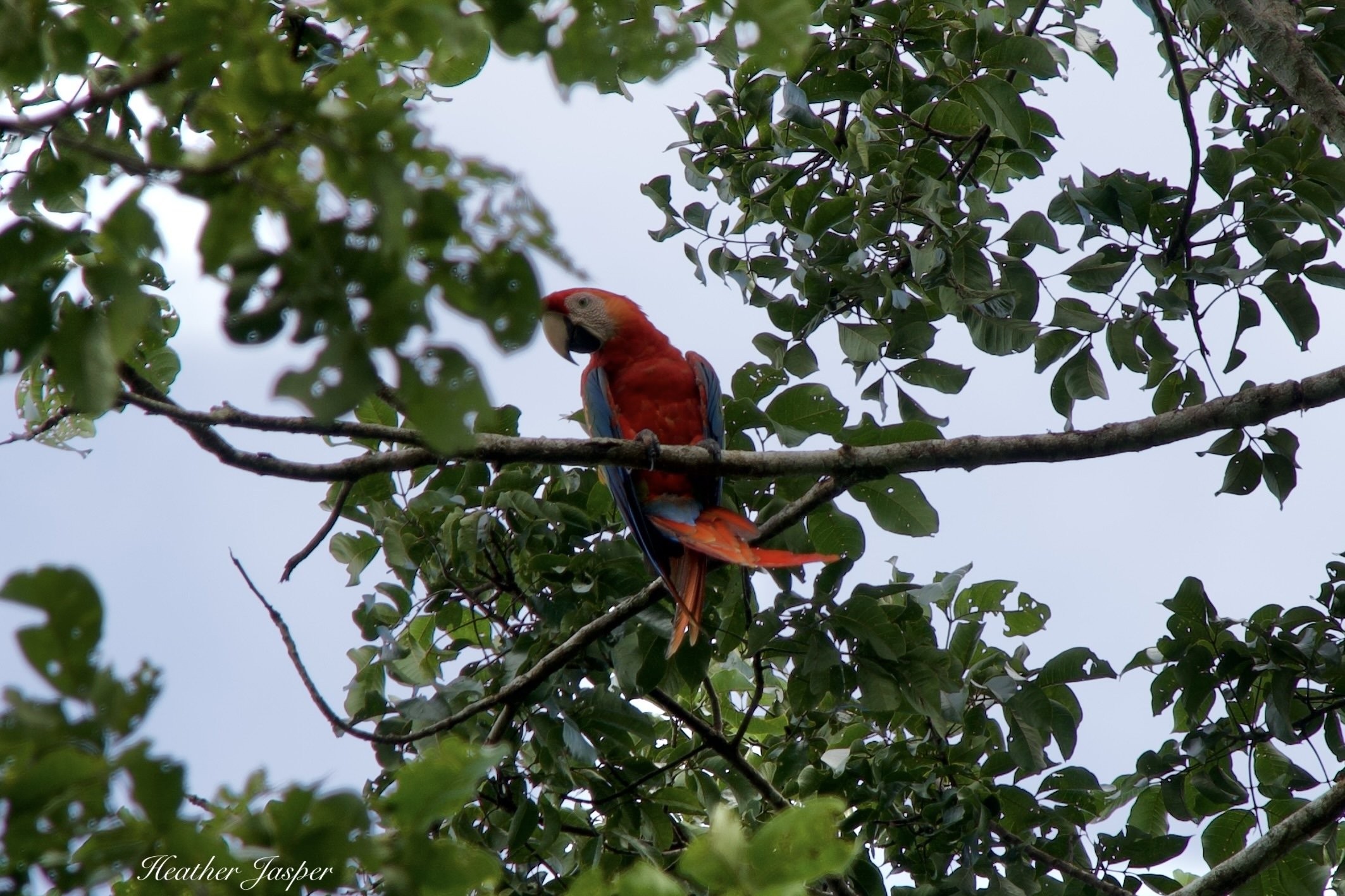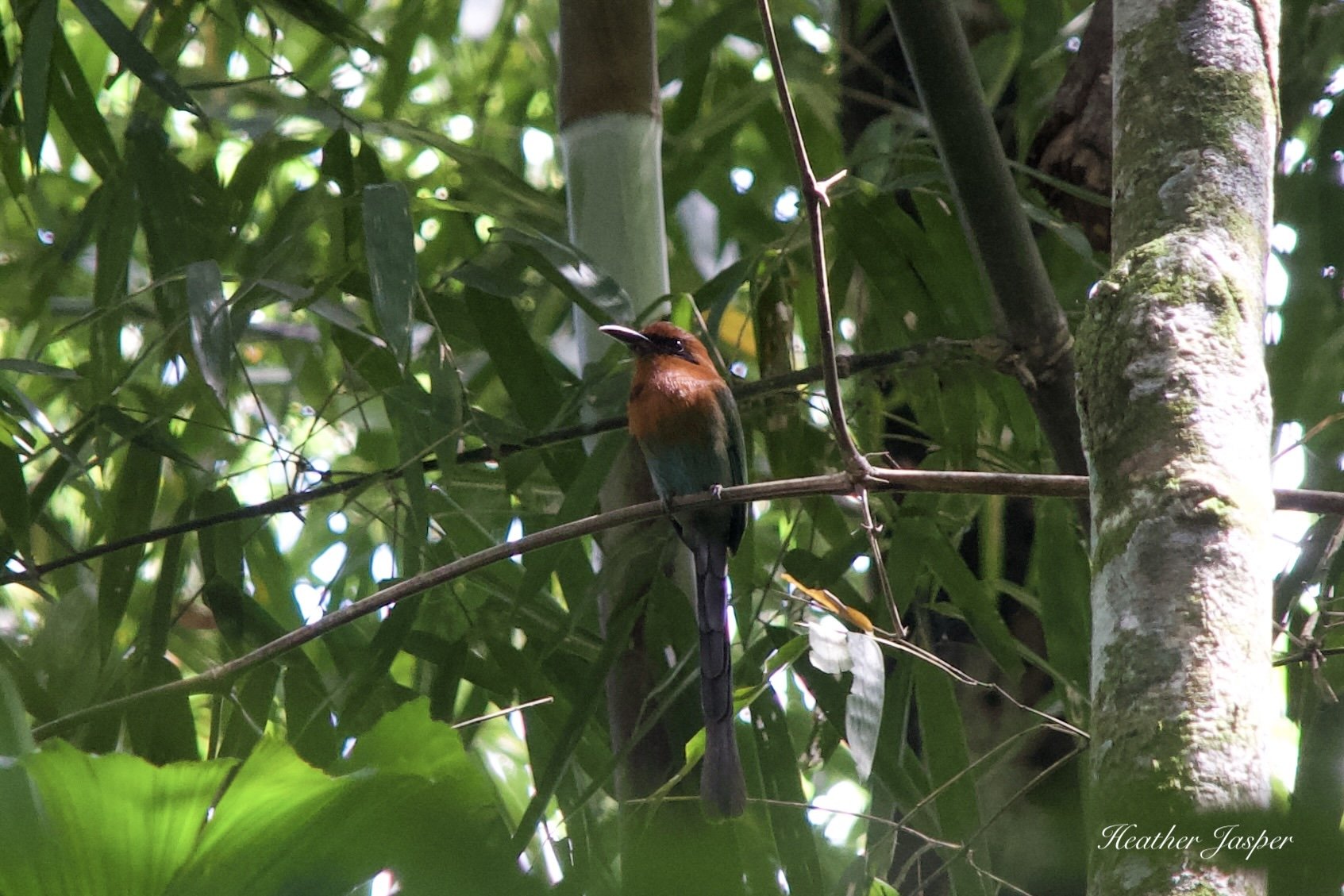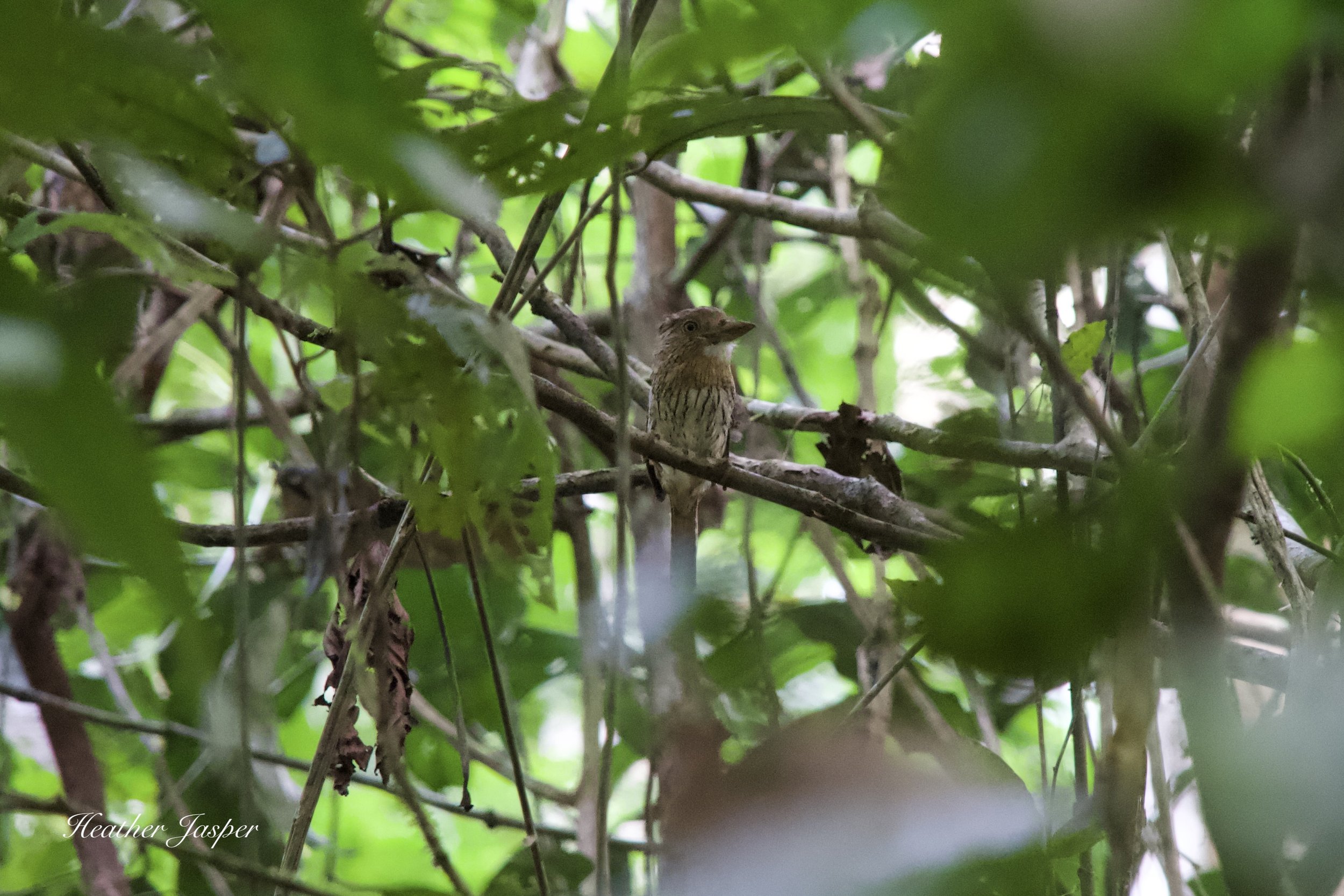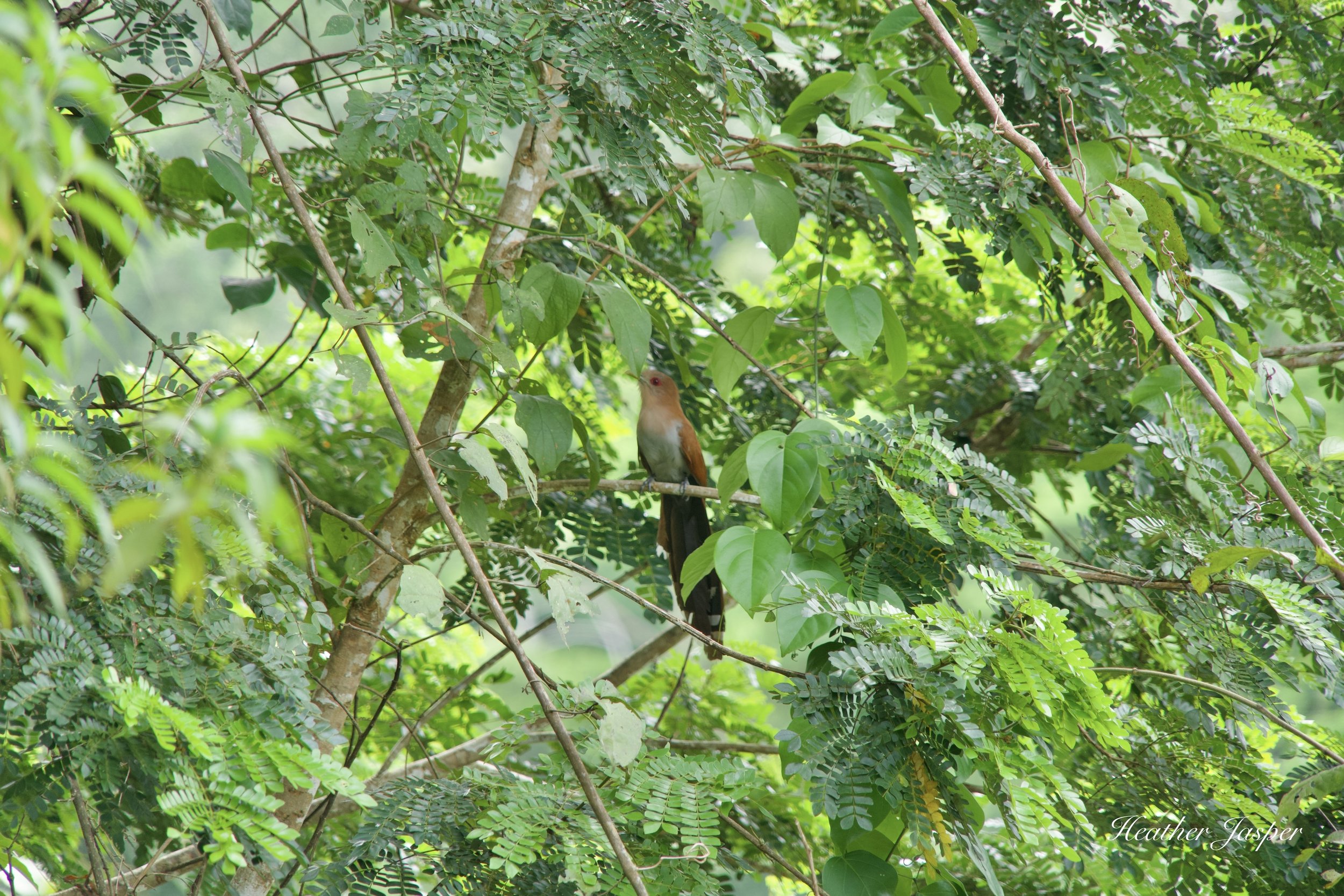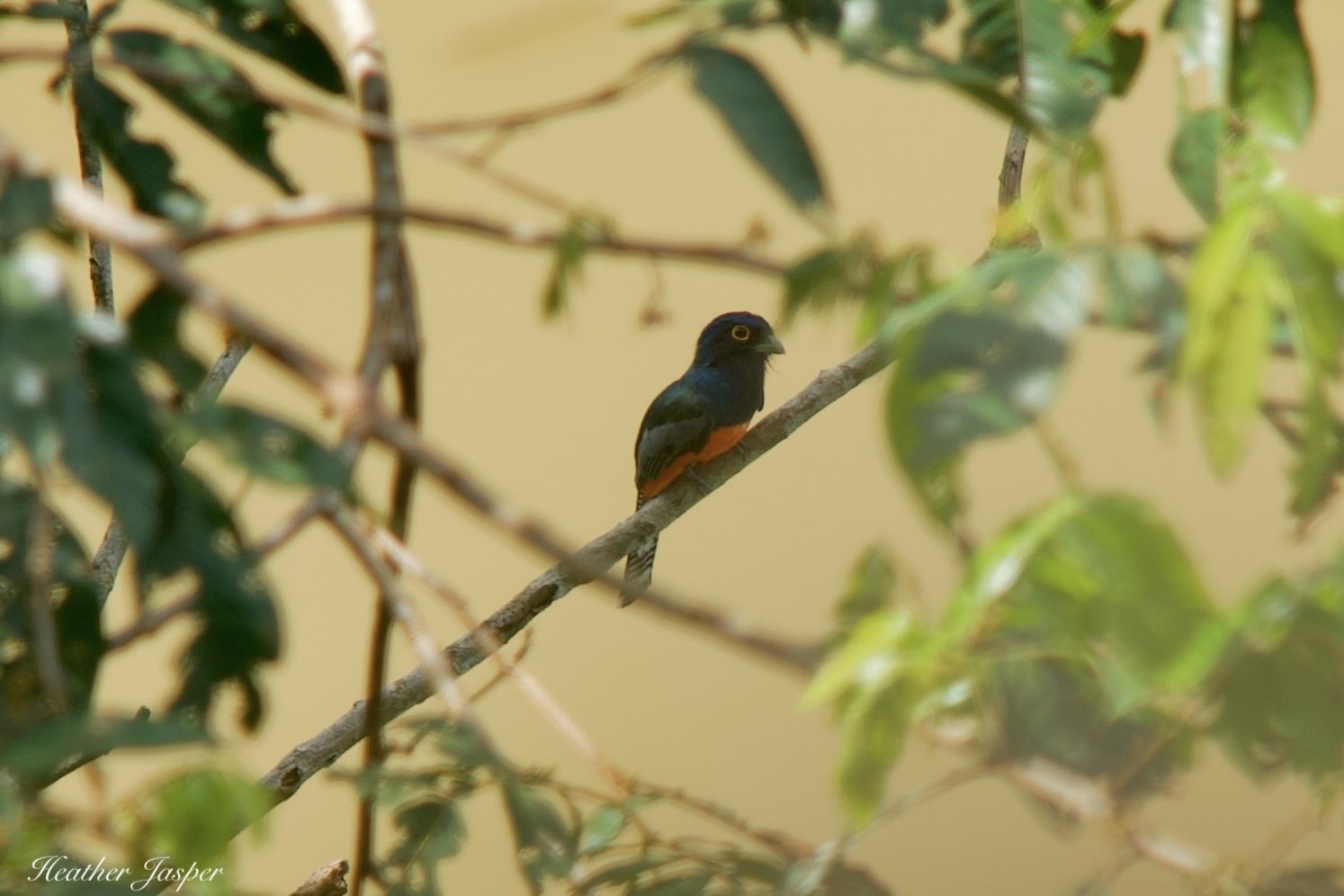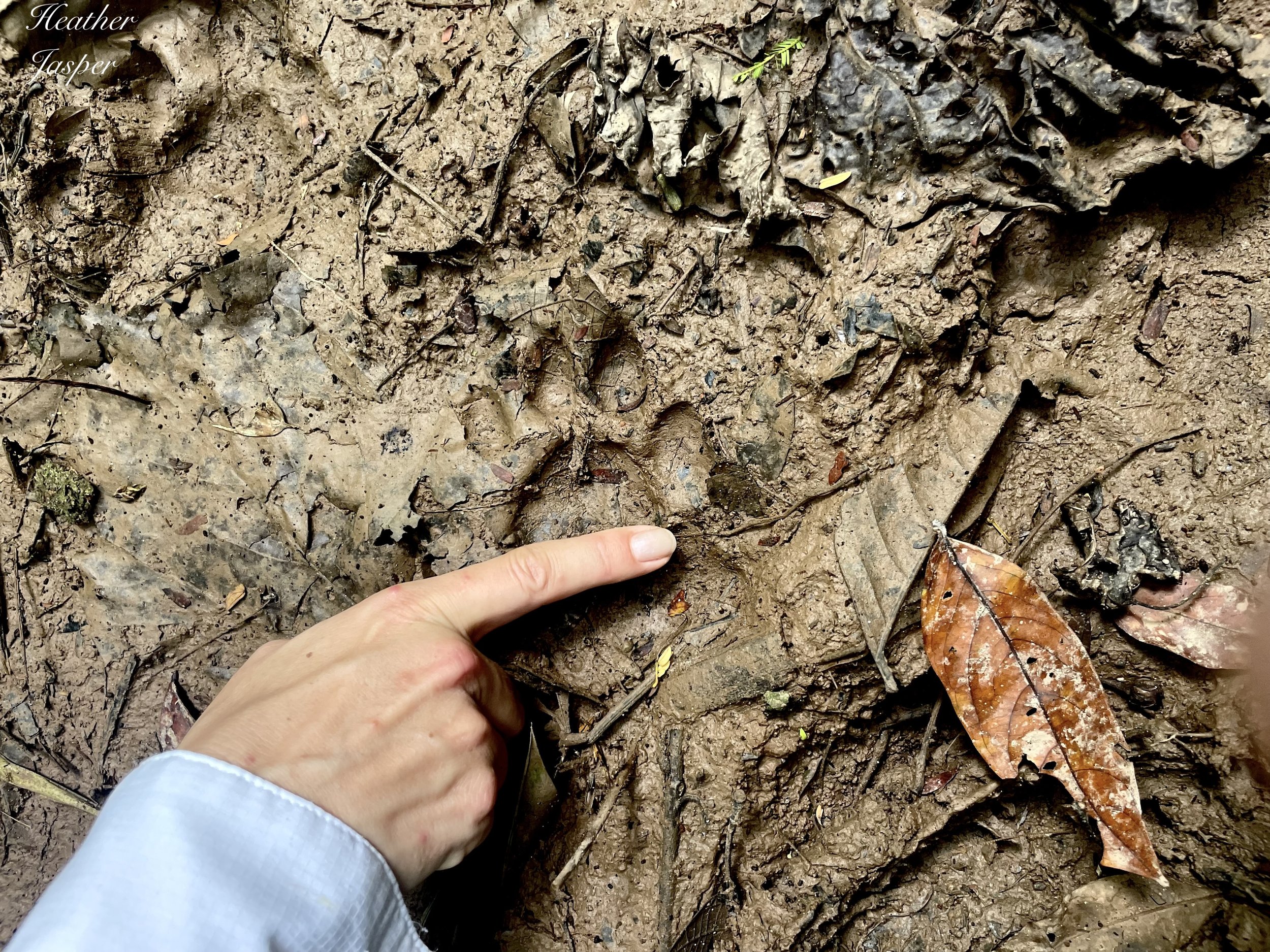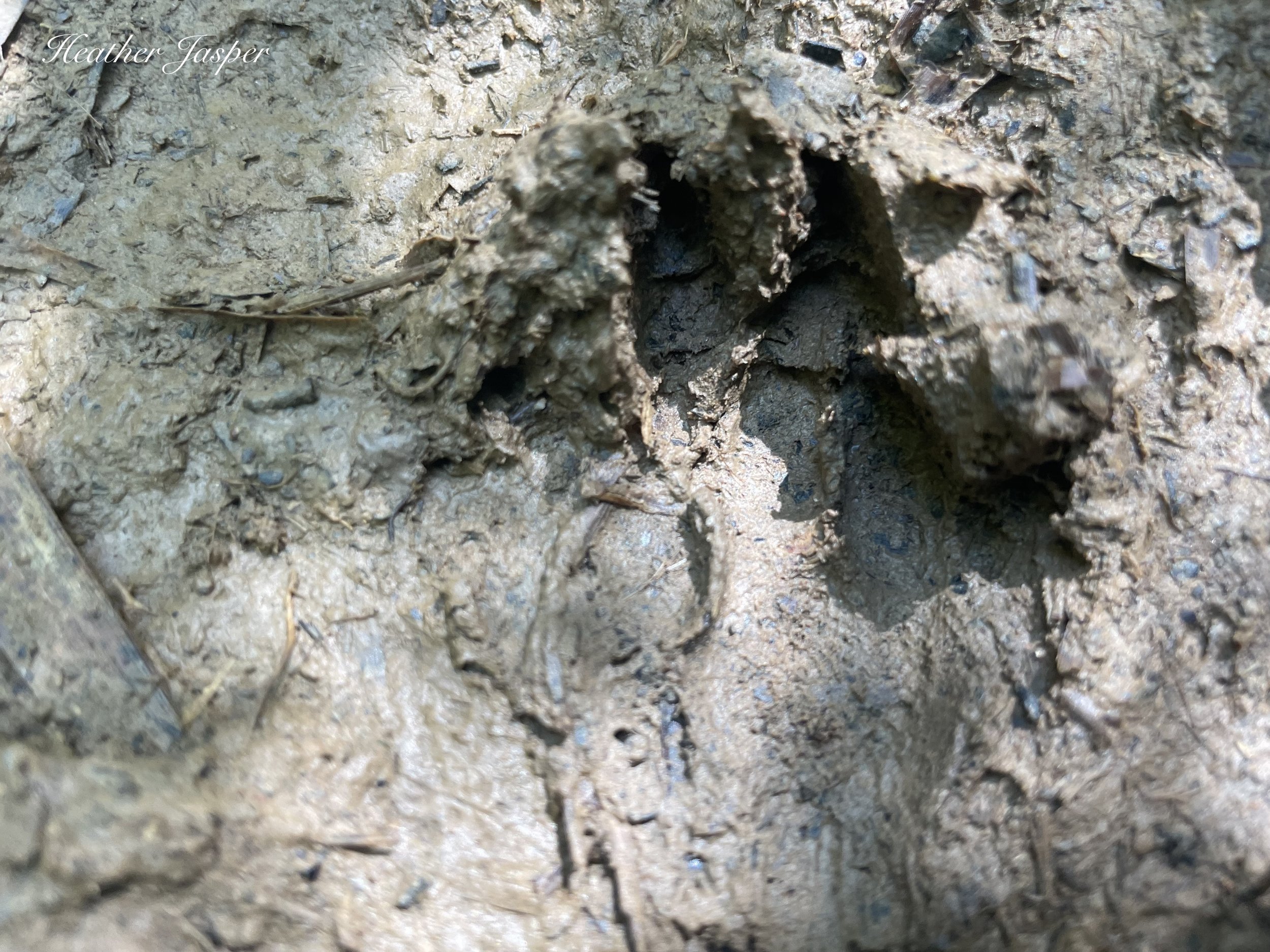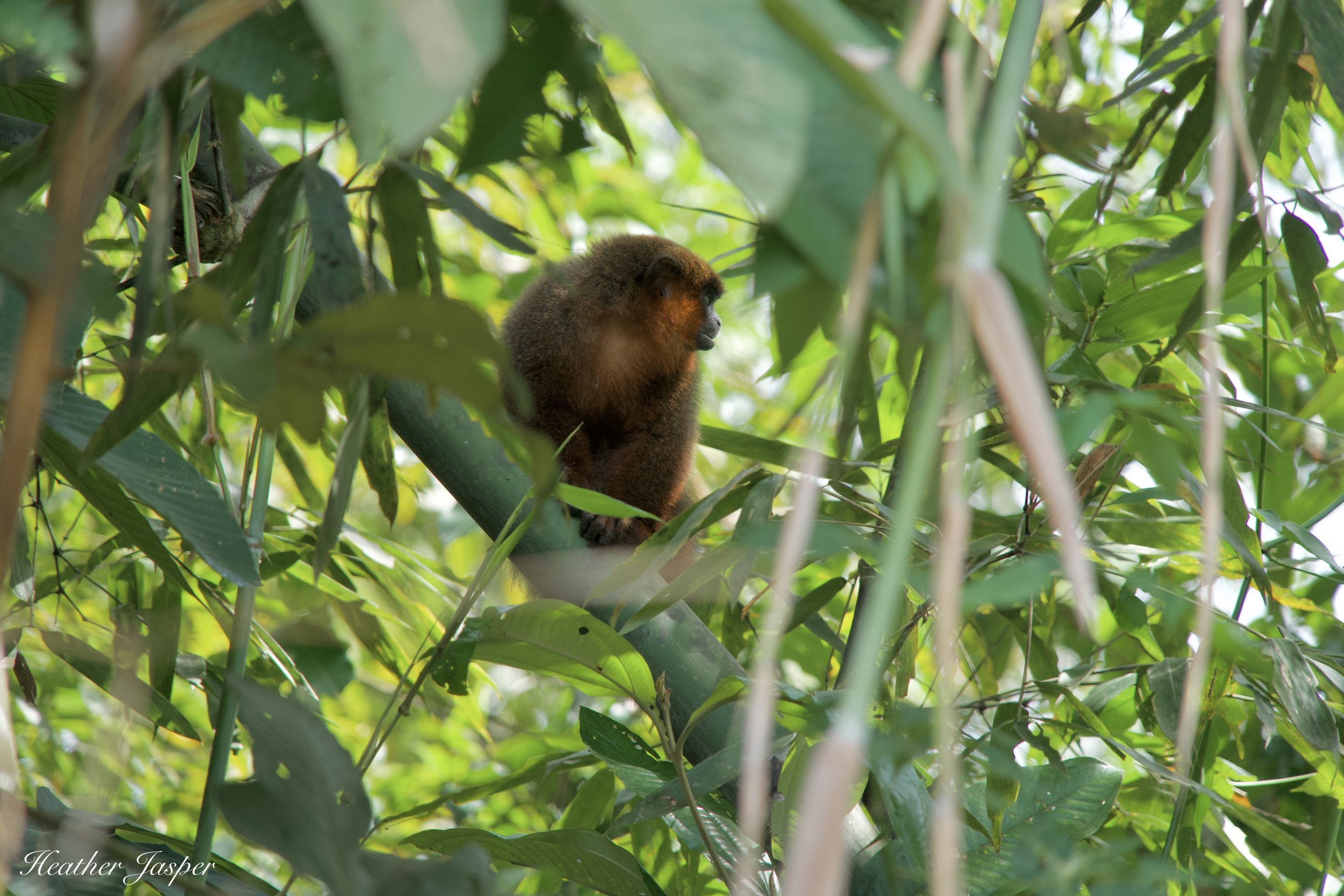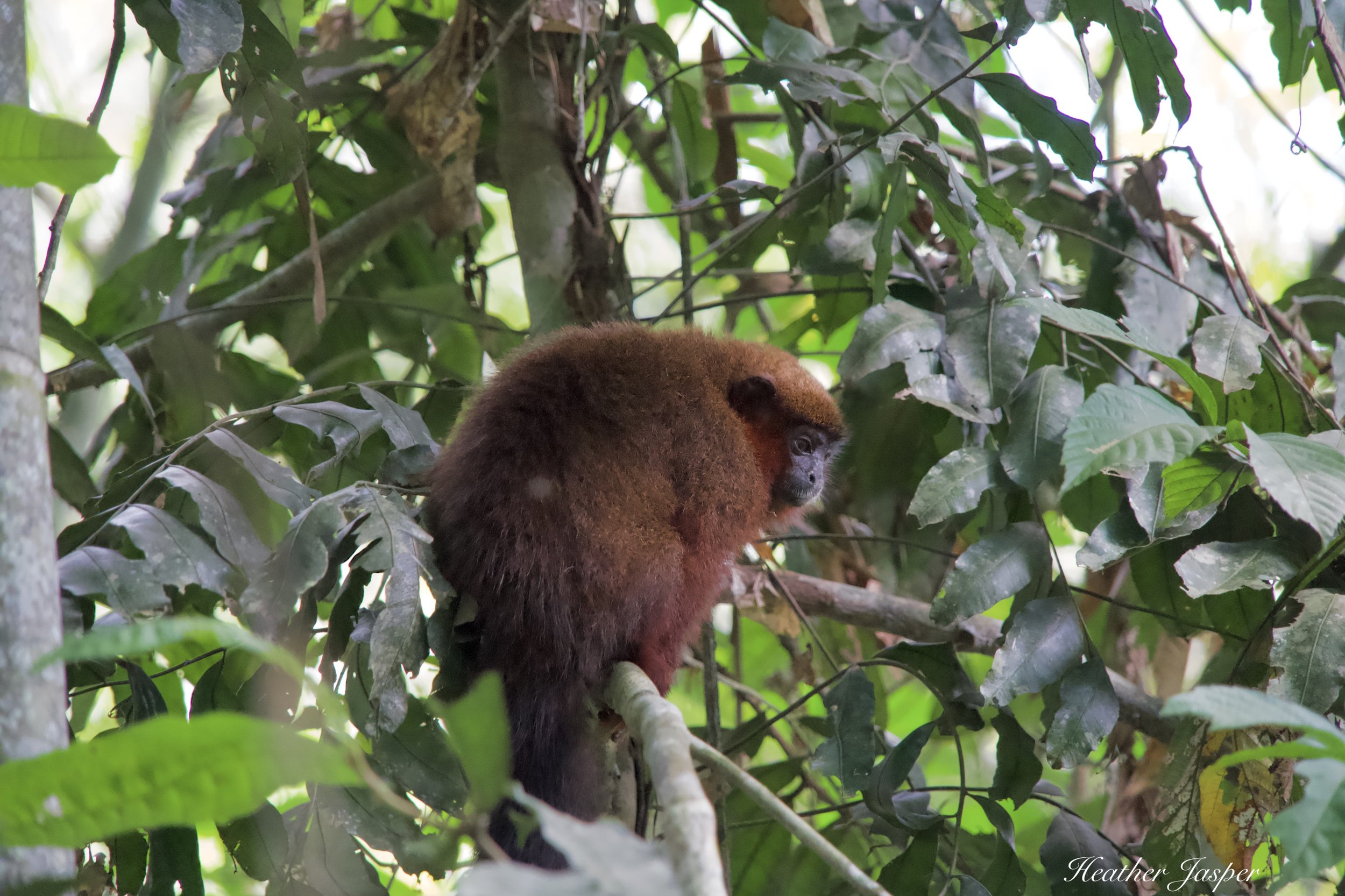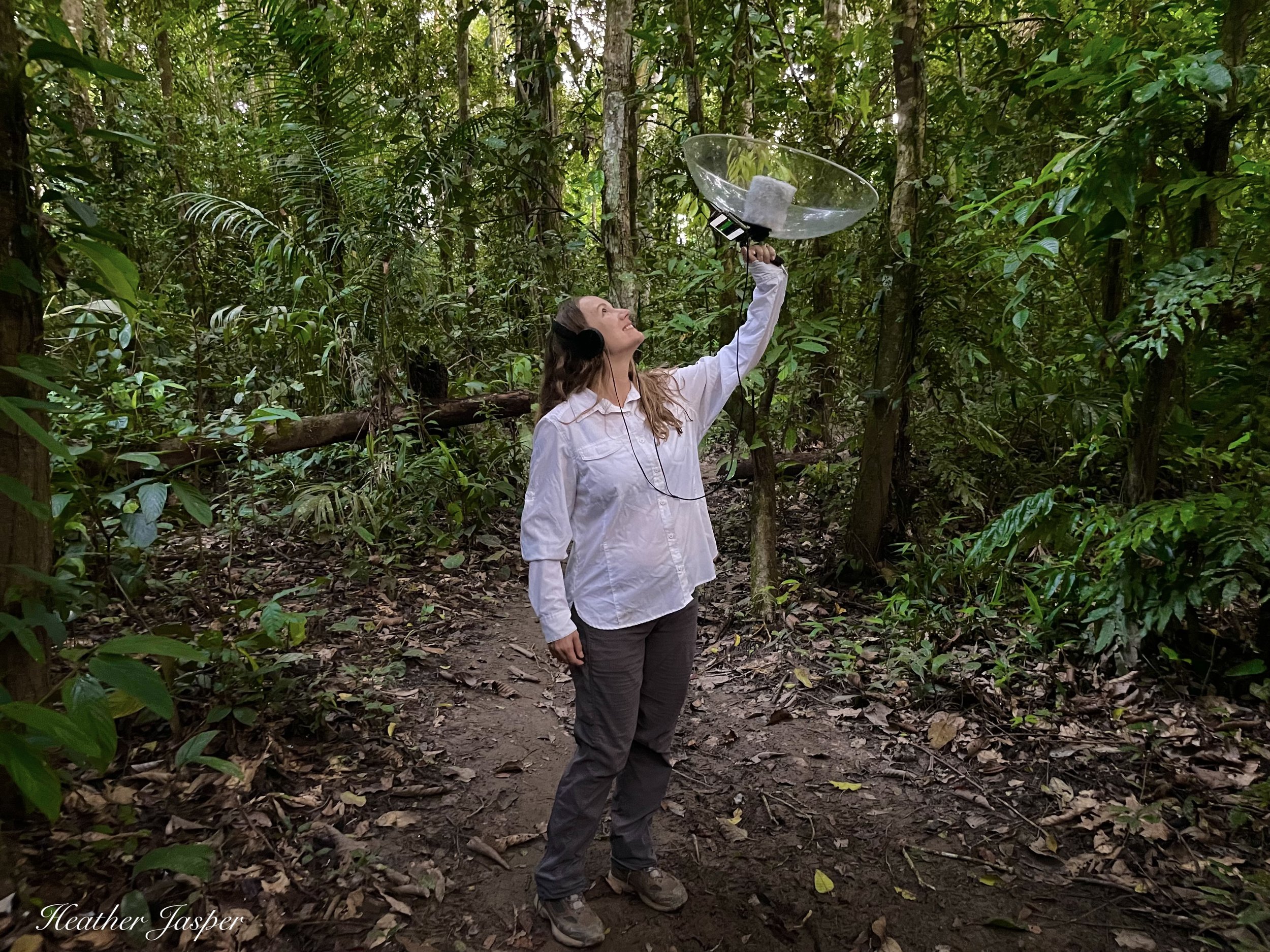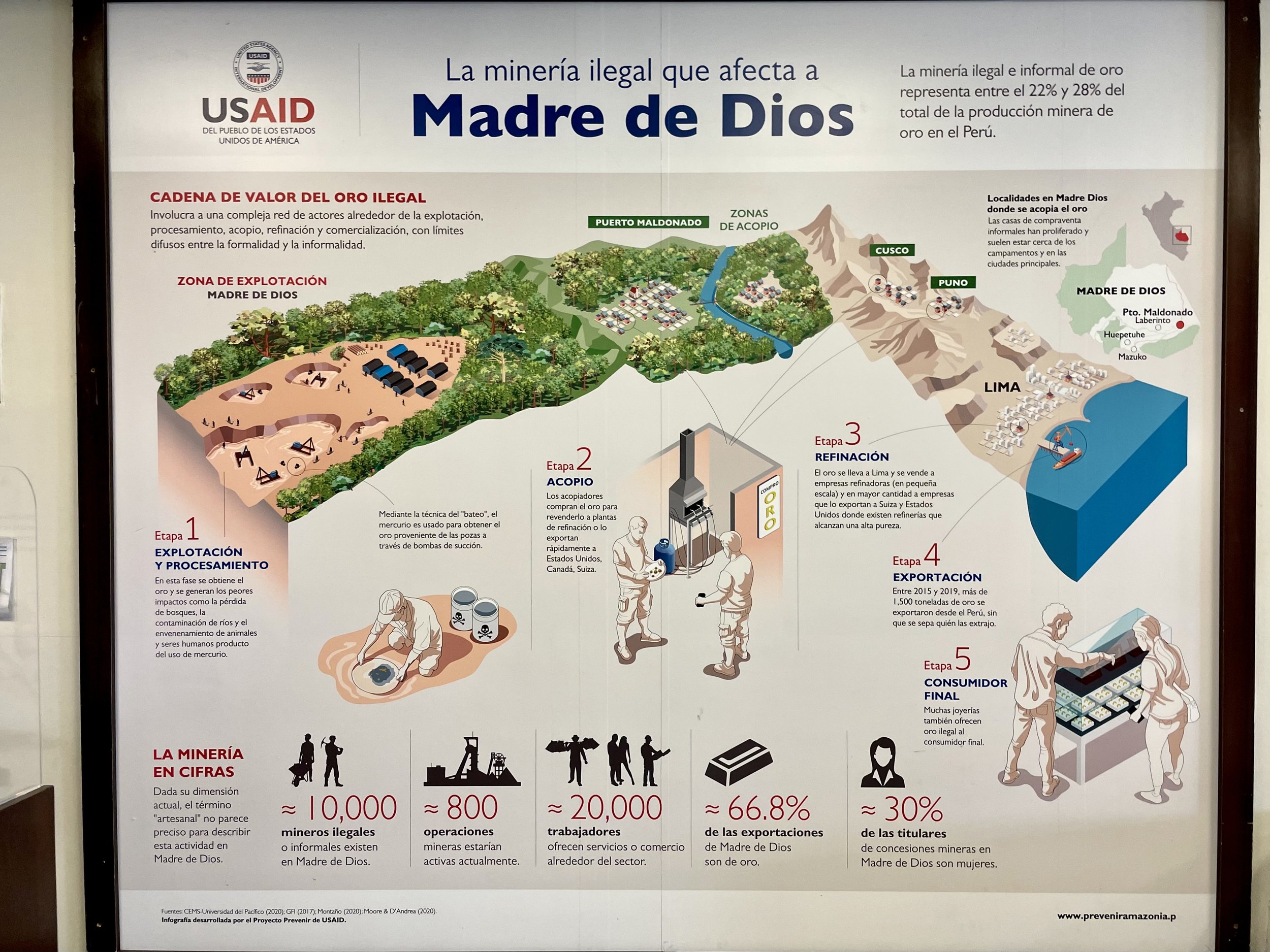Tambopata Research Center
My first morning at the Tambopata Research Center, while I was watching a Black-tailed Trogon, I felt eyes on my back. I turned around to see this Toppin’s Titi Monkey staring at me intently.
The third and final part of my adventure with Rainforest Expeditions was at the Tambopata Research Center. Read my full review of Rainforest Expeditions lodges in Luxury Latin America.
It was the cherry on top of an amazing adventure and absolutely my favorite part of the trip.
When I walked up from the boat, the manager Aixa greeted me, and I watched a welcome video with a family who had arrived on the same boat. (The greeting and video are similar at Posada Amazonas and Refugio Amazonas).
The lodges always have snacks and iced drinks available during the times of day when people arrive or come back from their morning or afternoon activities. I usually prefer salty snacks in the jungle because I sweat so much, but there were delicious cream puffs waiting for us this time and I happily indulged.
All three Rainforest Expeditions lodges have a baker on staff, who bakes fresh bread for every meal, plus desserts and snacks. Details like that make the lodges feel luxurious.
I met my guide, Saul, and we went over the activities available for the last two days of my trip while I snacked on the creampuffs and drank starfruit juice. (It was starfruit season, and the trees were overloaded). The Tambopata Research Center has most of the same activities as Posada and Refugio, which I’d just visited. However, what I was really excited about were the opportunities for citizen science. One of the biggest differences between the Tambopata Research Center (TRC) and the other two lodges is the teams of resident scientists.
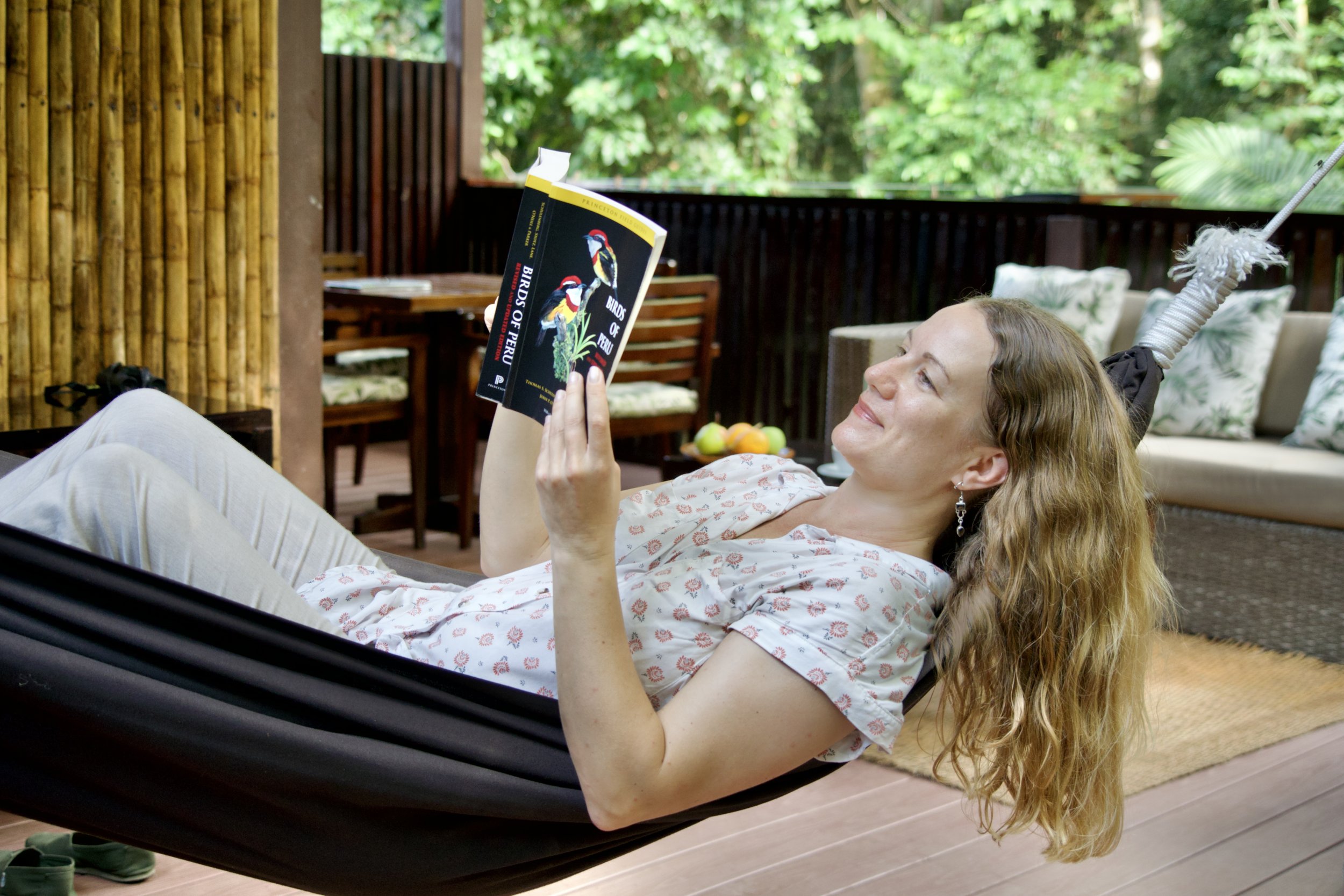
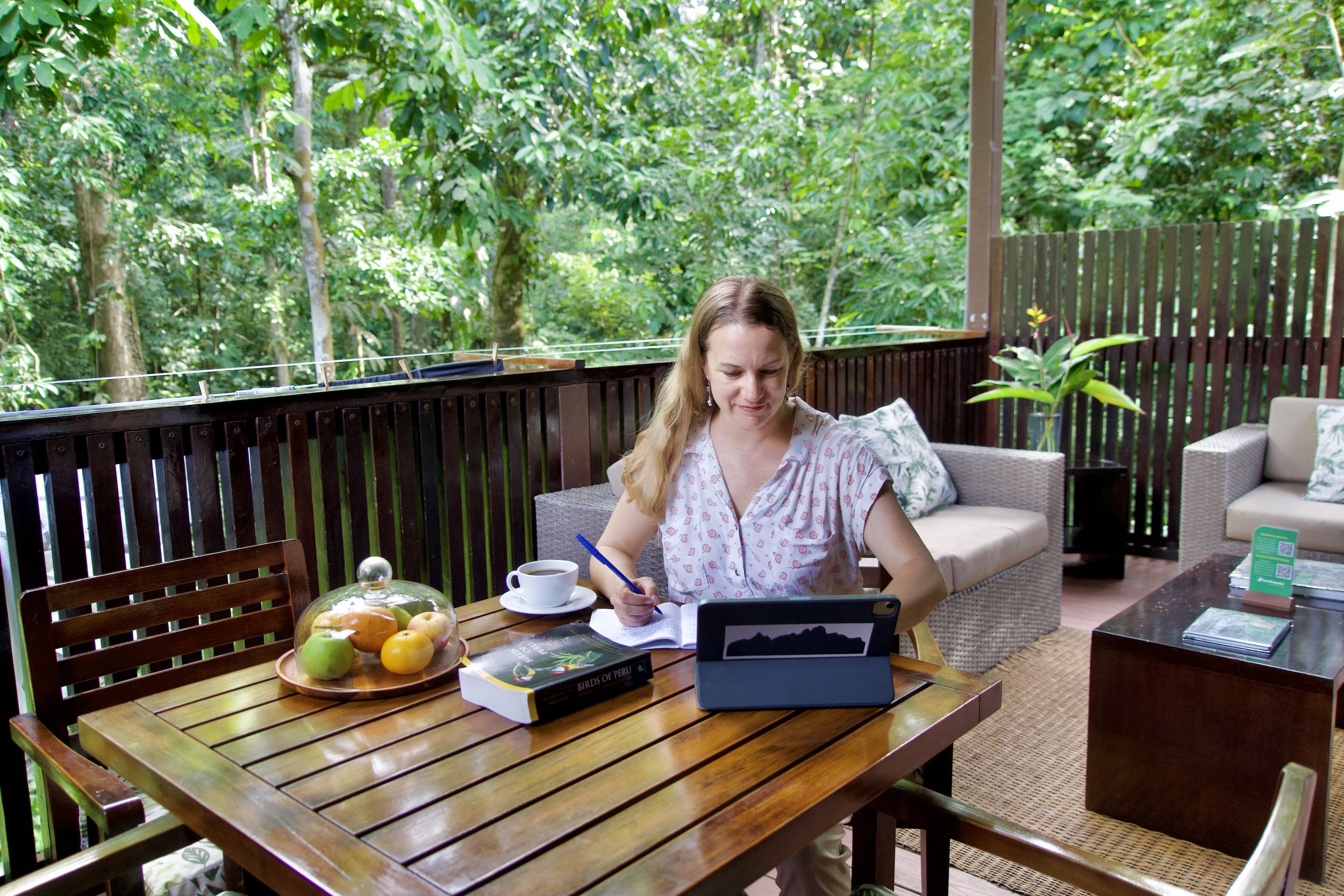
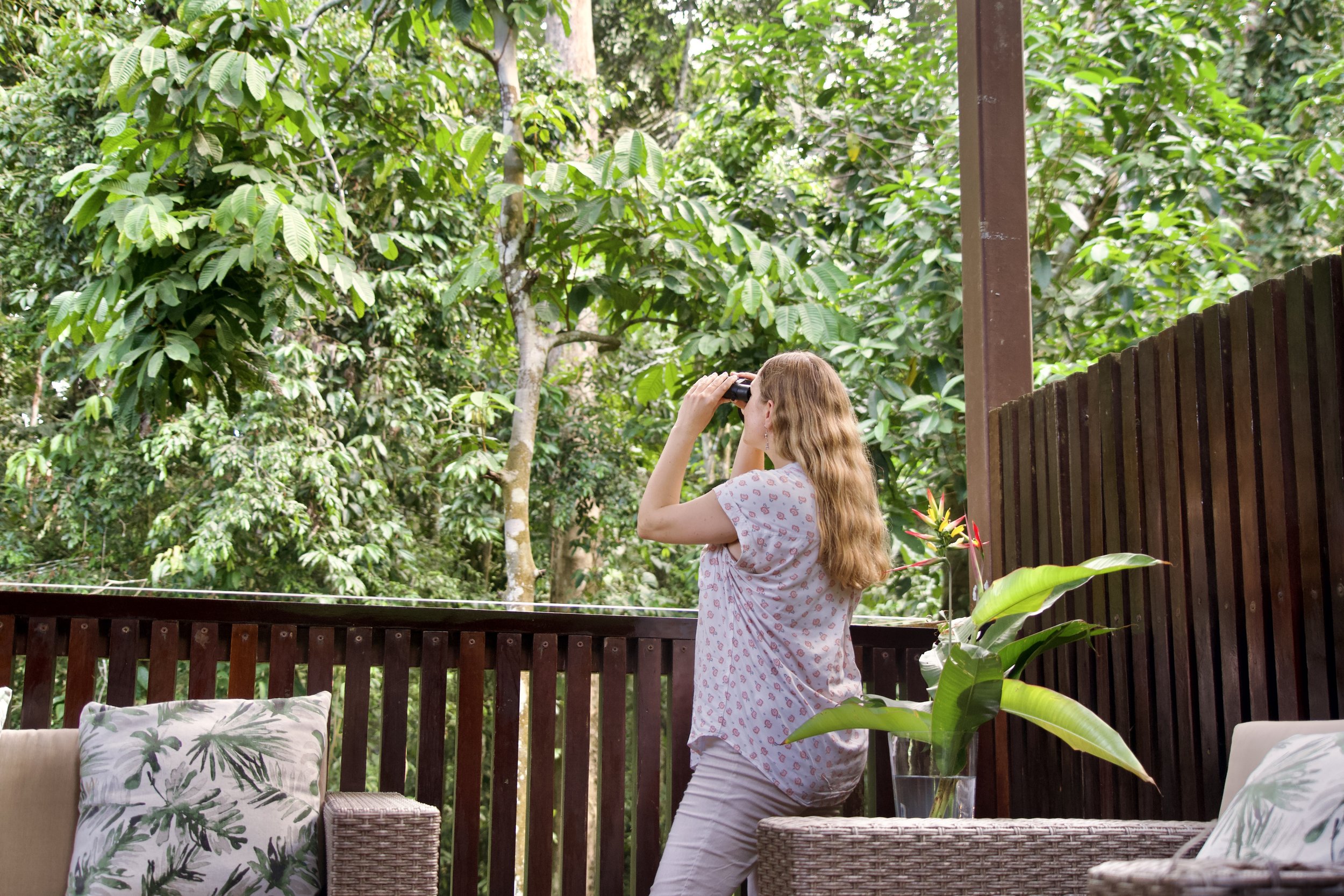
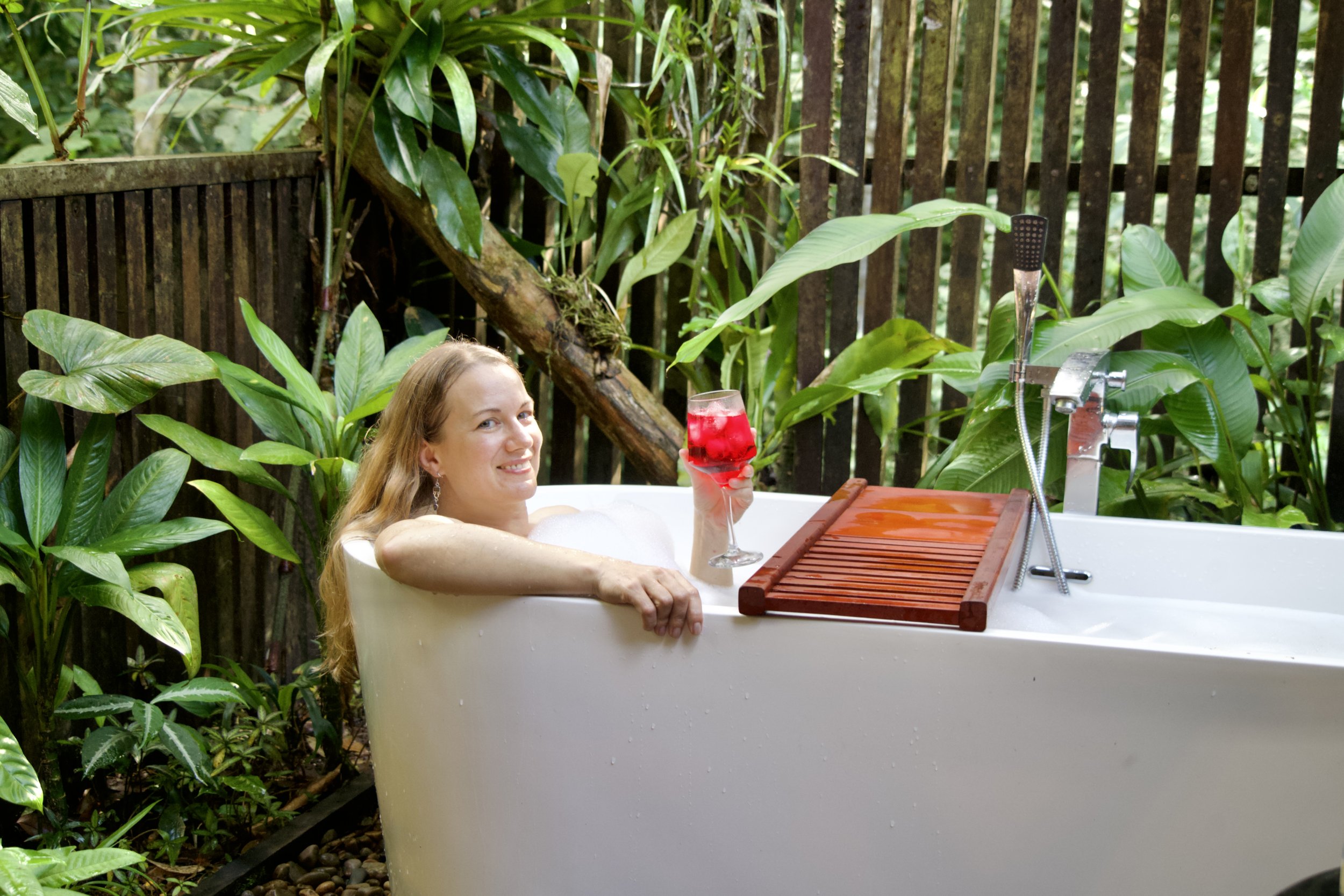
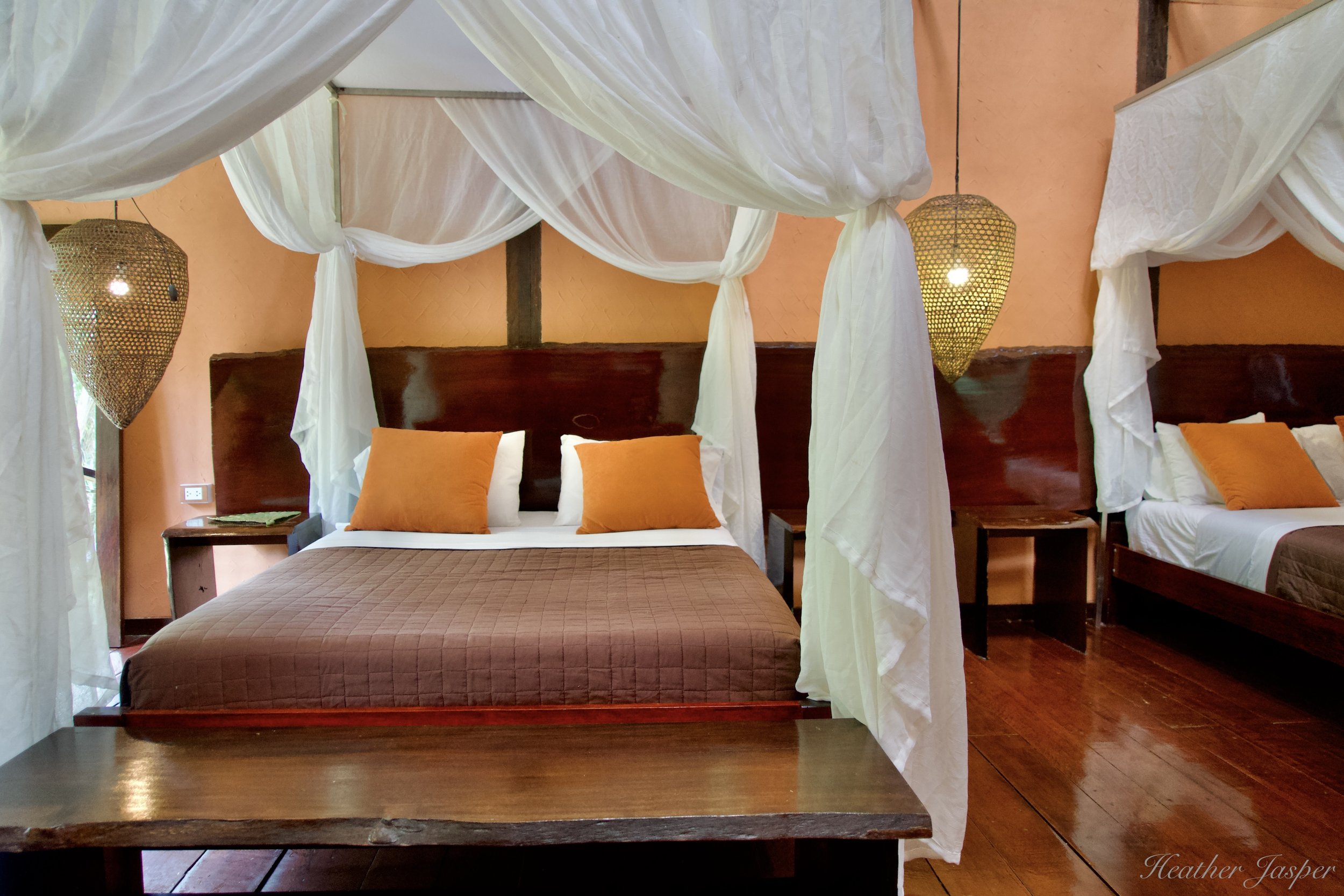
First, I settled into my Deluxe Suite.
The Deluxe Suite at the Tambopata Research Center has two queen fourposter beds, with elegant drapes for mosquito nets. I had a sitting area at the suite’s entrance and a bathroom fully stocked with rainforest-friendly, biodegradable products, a rain shower, and fluffy bathrobes.
The deck is extensive and the biggest perk over the regular suite. I had a table and chairs, which were perfect for catching up on a bit of work. Considering how deep I was in the jungle, the wifi strength was impressive. I also had a couch for relaxing and stuffed chairs, though I lounged in bed in the afternoons because I wanted the protection of a mosquito net.
The deck also had a hammock and an outdoor shower and tub. I supposed you could run hot water in and call it a hot tub, but I filled it with cold water in the afternoon and it was perfect. If you’ve read any of my other jungle blogs, you know that I do not handle heat and humidity well. Having my body fully submersed in cool water was the only time I wasn’t sweating profusely. It also completely protected me from mosquitoes.
The photos kind of say it all, but what’s missing is the constant sounds of the jungle: birds and monkeys stand out the most, but there are a million things in the rainforest that make noise. Some of them are particularly loud, like howler monkeys, screaming piha birds, and cicadas. Screaming pihas are much more melodious than their name implies, while howler monkeys are very aptly named.
Every evening there is a scientific lecture before dinner.
Guests usually get back from afternoon activities with an hour or so before dinner. You can go shower off the sweaty afternoon and get dry clothes for dinner or get a drink from the bar and sit back to learn about what the researchers are working on.
Monkey talk
My first evening I attended a lecture from the monkey team. They’re recording the vocalizations of eight species of monkeys in the forest around the Tambopata Research Center. The project aims to analyze the meaning of each vocalization, basically to understand what the monkeys are saying to each other. Think about that for a minute. They’re learning to understand eight different monkey languages. It’s incredible!
This wild macaw was raised by researchers in the 1990s, before they were strict about contact between wildlife and people. Today researchers are very careful to not let wild macaws get accustomed to people but some of the birds from the 90s still stop by the lodge now and then.
Saving macaws from extinction
My second evening it was the macaw team’s turn. This is the flagship project at the Tambopata Research Center. Since the 1990s, researchers there have been working on developing the perfect artificial macaw nests and they’ve now hit on what seems to be the ideal design.
Macaws usually lay three to four eggs, but only the first chick survives. If for some reason the first chick dies, it’s almost always the second one to hatch that survives. Of the six nests they installed near the lodge, two of those nests produced two chicks this year. Having two chicks fledge from one nest is almost unheard of in normal conditions and definitely a cause for celebration.
This macaw nest has two entrances at the top and several cameras on the nest and tree.
Why artificial nests?
Scarlet macaws prefer to nest in old growth Shihuahuaco trees (also called ironwood) which tend to lose a branch or two as they age past 300 years. The hole left by the branch is where macaws nest.
Ironwood is one of the most sought-after rainforest hardwoods and illegal logging has decimated their population. (In the US it’s sold as Brazilian teak or cumaru. Please don’t buy this!) Rather than plant more ironwood and wait 300-500 years, scientists are trying to do something that will help the macaw population now. Even waiting another 10 years risks not having any macaws left to save.
The artificial nests can be attached to any sturdy tree. It doesn’t have to be ironwood and it doesn’t have to be 300 years old. It’s complicated to replicate the cool interior of a living tree, create a nest that predators can’t get in easily, make it an environment that repels parasites and diseases and uses locally available materials that aren’t too expensive. Yet through years of hard work, they’ve clearly done it. The proof is the six nests that have live chicks in them as I write this.
Check out the Wired Amazon website for more information.
Don’t wear white unless you want moths all over you - like I did.
The Tambopata Research Center is both for science and for tourism.
The projects at TRC focus on wildlife: monkeys, macaws, moths, and whatever wildlife they capture with the camera traps. There is also an aerobotany project that studies the rainforest canopy with drones and a Harpy Eagle cam, but they’re at Refugio.
After dinner on my first evening, Saul took me on a short walk through the forest to where the moth team works every evening. He recommended that I wear dark colors, but I had packed a white scarf just in case I had the opportunity to do the moth activity I’d seen on the Wired Amazon website.
Officially called Discovering New Species, the moth team gathers every night by a white sheet, lit on one side, and traps any moths they don’t recognize. It’s painstaking work, but they analyze so many moths that they have so far found more than 20 new species.
A habitual visitor
This cane toad came by the moth team every evening to snack on the cicadas that were also attracted to the moth light.
Birding at the Tambopata Research Center
The next morning Saul and I walked the trails to an area of bamboo forest, which has different birds from the ones I’d seen at Posada and Refugio. Along the way we saw tayra (Eira barbaba) and puma footprints in the mud.
While tayra are relatively easy to identify from the footprints, we had no idea what kind of giant cat prints we were seeing. It was only later when Saul checked with the camera trap team that he found out they had seen a puma in the area recently. It’s exciting to know that pumas are there, but it’s almost impossible to see one. I was happy enough with the birds.
We saw a lot of birds along the trails, like jacamars and mot mots, but it was when we got to the overlook that it was a constant parade of rainforest species. Some birds perched below us for long periods. I got to watch a Black-tailed Trogon just below us for well over half an hour. Some Blue-throated Piping Guans perched in another tree for almost as long. Reddish Hermits came and went, as did several Southern Rough-winged Swallows and a variety of tanagers. A Squirrel Cuckoo hung around for about fifteen minutes, then was replaced by a Scarlet Macaw, possibly a resident of one of the artificial nests, out looking for food for its chicks. (Full bird list at the end of the blog).
The best birding spot
This overlook was my favorite birding spot at the Tambopata Research Center.
We watched the birds, staying still and quiet, for so long that a family of Toppin’s titi monkeys crept up behind us. They’re not quiet and when I could tell they were close I turned around slowly and found one staring right at me. They were so close and so clearly unbothered by me and Saul that I filmed them with my phone.
These are not monkeys that are habituated to people at all. They are 100% wild and probably would never have some so close if we hadn’t been so quiet and still for almost an hour. Eventually I was out of water and the heat was getting so bad that we had to go back to the lodge. I took a cold shower, put on dry clothes for lunch. After eating, I went straight back to my room and sat in the cool tub on my deck until 4:00 when I went to meet the monkey team.
My macaw nest
I had a clear view of this nest from my tub, but I only saw macaws there in the evening.
From my deck I could see one of the artificial macaw nests, but they weren’t active that afternoon. I kept glancing up at the nest but didn’t see the pair until evening. Before they came back, it was time to put on clothes and mosquito repellant and go meet the monkey team.
Every afternoon, guests are invited to join the primate biologists as they track families of monkeys through the forest, listening in on their conversations and recording them. I tried on the headphones and held the microphone up, amazed at how clearly I could hear every mutter and murmur that came from the monkeys high above. I probably could have heard a monkey whisper, though I’m not sure they do whisper.
Eventually, it was time to go back for the lecture from the macaw team, and dinner. I gave the biologists back their specialized equipment, thanked them and wished them luck in understanding what the monkeys are saying.
Listening in on monkey conversations high above me in the rainforest canopy.
The last night at Tambopata Research Center
I loved the trip, even though the heat was too much for me. That night I lay in bed with the ceiling fan on, fanning my face with one of the half-dozen fans that are strategically placed around every room and suite at all three Rainforest Expeditions lodges.
The next morning I had a leisurely breakfast and afterwards was eager to get to the boat, knowing that the breeze on the river would be a relief from the already stifling heat. The rainforest is never easy for me, but it’s always worth it.
Being guided through the jungle by Rainforest Expeditions was one of my best trips to the Peruvian Amazon.
A glass butterfly, one of the many beautiful butterflies in the rainforest.
How to get there?
First, you fly to Puerto Maldonado in southern Peru. If you’re already in Cusco, it’s less than an hour flight. Just about anywhere else, I would recommend driving because of the carbon cost of short flights. However, the road is frequently washed out because it’s where the Andes meets the rainforest. Also, in 2023 there were a few incidents of highway robbery on the road to Puerto Maldonado. It’s not a particularly safe area.
The boat to TRC
The boat to the Tambopata Research Center has helpful maps to show how much time it takes to get from the office to the river and how much time you’ll spend on the boat.
I loved the boat rides because the breeze kept me cool and there was a lot of wildlife along the river: birds, caiman, deer, tayra and more.
However, the airport in Puerto (as the locals call it) is quite safe. Rainforest Expeditions will pick you up at the airport and first take you to their office, where you can repack if needed or freshen up. It’s best to use the bathrooms there, because the journey to the Tambopata Research Center is an hour and a half in a bus, then two hours in a boat. After only 20 minutes in the boat, you stop at a ranger station when you enter Tambopata Nature Reserve and you can use the bathroom there, but that’s your only chance in almost four hours of travel.
The biggest threat
Dredge mining for gold is the biggest threat to the rainforest in this part of Peru. Please do not buy gold from Peru as so much of it comes from rainforest destruction.
Packing for the jungle
Wondering what you need to pack for a trip to the rainforest? Read my jungle packing tips!
Birds seen at TRC: Scarlet Macaws, Plain-throated Antwren, Chestnut-fronted macaws, Black-faced ant thrush, Orange-cheeked Parrot, Bluish-fronted Jacamar, Blue-headed Parrots, Black-throated Antbird, Plain-winged Antshrike, Golden-collared Toucan, Black-tailed Trogon, Blue-and-Yellow Macaws, Black-fronted Nunbird, Blue-crowned Trogon, Chestnut-tailed Antbird, Chestnut-eared Aracari, White-throated Toucan, Mealy Parrots, Cobalt-winged Parakeets, White-bellied Parrots, unidentified Woodcreeper, Blue-throated Piping Guans, Reddish Hermit hummingbird, Broad-billed Mot Mot, Roadside Hawk, Yellow-rumped Cacique, Red-and-Green Macaw, Tropical Kingbird, Blue-gray Tanager, Southern Roughwing Swallow, White-banded Swallows, White-throated Jacamars, Cpeckled Chachalacas, Squirrel Cuckoo, Amazonian Parrotlets, Russet-backed Oropendolas, Social Flycatchers, Crimson-crested Woodpecker, Greater Anis, Bare-necked Fruitcrow, Masked Titayra, Ruddy Pigeon, Masked Tanager, Spot-winged Antbird, Striolated Puffbird, Collared Trogon, Cinerous Tinamú, Spix’s Guan, Buff-throated Woodcreeper and many others that I didn’t manage to identify.
Mammals at TRC: Saddle-back Tamarin monkeys, Toppin’s titi monkeys, Spider monkeys, tayra tracks, puma tracks, deer tracks (probably red brocket deer)

